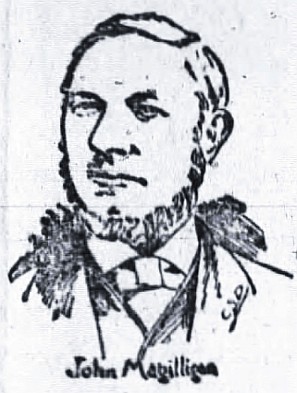
 John J. Magilligan, owner-architect-builder. He partnered with his wife Mary (Rice) Magilligan. He lived at 56 Berkeley Place and did a great deal of building in the north end of the Park Slope District. He built more than 100 speculative houses in Park Slope. According to his Obituaries he retired in 1896, after being stricken with paralysis [a stroke]. Genealogy: Born 1830, Died August 7, 1907. Married Mary Rice in 1860 (Born 1838, Died June 5, 1914).
John J. Magilligan, owner-architect-builder. He partnered with his wife Mary (Rice) Magilligan. He lived at 56 Berkeley Place and did a great deal of building in the north end of the Park Slope District. He built more than 100 speculative houses in Park Slope. According to his Obituaries he retired in 1896, after being stricken with paralysis [a stroke]. Genealogy: Born 1830, Died August 7, 1907. Married Mary Rice in 1860 (Born 1838, Died June 5, 1914).
A biography on John Magilligan is in the Google book: History of Long Island: From Its Earliest Settlement to the Present Time.
His earlier work was in the Italianate style, but over the years he progressed through the neo-Grec, Queen Anne, and Renaissance Revival styles. He was also actively involved in marketing these houses throughout the period, during which he placed classified advertisements in the local newspapers offering the houses for sale. [From Crown Heights Landmark Designation Report]
I went through Landmark Designation Reports to find most of these houses. Others were found by looking for Magilligan's real estate newspaper listings in the Brooklyn papers. Total 120 or more houses, plus three contiguous apartment buildings. Longer rows were built in a couple stages. You can see a seam between two houses, instead of a party wall.
| When Built | Address | Location | House Count |
|---|---|---|---|
| 1860-1865 | ? | ||
| 1866 | 49-57 S Portland Ave | [e s Lafayette-DeKalb] | ? |
| 1867 | 257 Carlton Ave | [e s DeKalb-Willoughby] | 1 |
| 1869 | 79-83 St Marks Ave | [n s Flatbush-Carlton] | 3 |
| 1870-1872 | 115-123 Park Pl | [n s 6th-7th Aves] | 5 |
| 1871-1872 | 122-130 Park Pl | [s s 6th-7th Aves] | 5 |
| 1873 | 38-50 Sterling Pl | [s s 5th-6th Aves] | 7 |
| 1874-1875 | 44-62 St Mark's Ave | [s s 5th-6th Aves] | 10 |
| 1876-1877 | 89-97 Sterling Pl | [n s 6th-7th Aves] | 5 |
| ? | |||
| 1879-1880 | 118-120 Park Pl | [s s 6th-7th Aves] | 2 |
| 1880 | 112-116 Park Pl | [s s 6th-7th Aves] | 3 |
| 1881 | 56-64 Berkeley Pl | [s s 5th-6th Aves] | 5 |
| 1882-1883 | 184-202 Berkeley Pl | [s s 7th-8th Aves] | 10 |
| 1884-1885 | 865-887 Union St | [n s 7th-8th Aves] | 12 |
| 1886 | 749-763 Carroll St | [n s 7th-8th Aves] | 8 |
| 1887 | 765-775 Carroll St | [n s 7th-8th Aves] | 6 |
| 1888-1889 | 777-789 Carroll St | [n s 7th-8th Aves] | 7 |
| 1889 | 786-804 Carroll St | [s s 7th-8th Aves] | 9 |
| 1891-1893 | 480-498 1 St | [s s 7th-8th Aves] | 10 |
| 1894 | 258-264 Garfield Pl | [s s 7th-8th Aves] | 4 |
| 1895 | 1263-1277 Bergen St | [n s Brooklyn-Kingston] | 8 |
Starting in 1892 the real estate classifieds were signed "John Magilligan & Son." John, the father, was retired by 1896 according to his obituary. In "History of Long Island" it has he retired in 1891, which is in sync with the addition of "& Son." Any later buildings attributed to a John Magilligan would have been built by his son (who had the same name). After having great difficulty selling 1263-1277 Bergen St, they switched to building an apartment building at 1162-1166 Pacific Street.
There is a slide show of the 1940s tax photos of Magilligan's houses.
I made a walking tour of Magilligan's houses in built date order. Only one small change is needed to make it efficient.
To view a large picture, click on the thumbnail. Then with some browsers (e.g. Firefox) you have to click a second time to get the image to fit the screen.
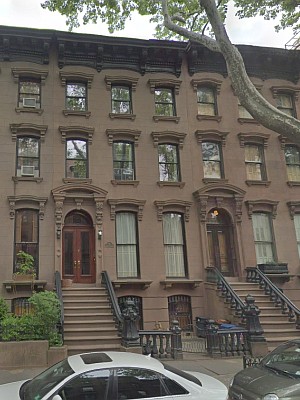 1867: 49-57 S. Portland Ave [e s Lafayette-DeKalb Aves]
1867: 49-57 S. Portland Ave [e s Lafayette-DeKalb Aves]
Nos. 49-57 are a row of five typical Italianate houses erected c. 1866. Although built as a uniform row, it is difficult to determine who the builder was since the building lots were frequently exchanged between three builders who were active in the area: Richard Claffy, John Magilligan and William Flanagan. These houses use fairly traditional Italianate forms including round-arched door enframements with segmental-arched pediments resting on foliate brackets, rusticated basements, table sills, eyebrow lintels and wooden bracketed cornices. No. 55 retains its original Italianate cast iron railings. The neo-Grec style ironwork at Nos. 51 and 53 was probably added in the 1870s. The stoop walls, areaway parapets, and ironwork at Nos. 49 and 57 are of a later period. The table sills have been removed at No. 55. These houses were sold in 1866-67: No. 49 to New York City lawyer Charles C. Converse, No. 51 to D.M. Bacon, an umbrella merchant, and No. 55 to Valentine Snedeker, a clothing merchant.
Whether John Magilligan built these or not, it is highly likely he was the architect, as he also designed houses for other area builders. The only difference between this row, and the next house, is this has a scallop at the bottom of the cornice, and the next is straight. But then back to the scallop.
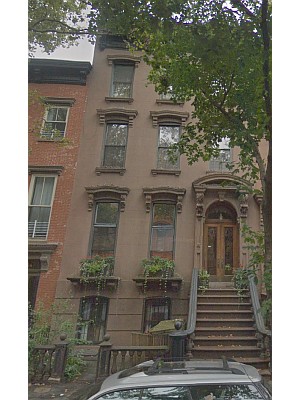 1867: 257 Carlton Ave [e s DeKalb-Willoughby Aves]
1867: 257 Carlton Ave [e s DeKalb-Willoughby Aves]
This house was found in a newspaper classified advertisement. This is the only single brownstone on this side of the street. The designation report does not list a builder. It has:
No: 257 is a tall, Italianate brownstone residence erected in 1867 for clothing merchant John N. Eitel. The house is ornamented with such typical Italianate details as a rusticated basement, ornate doorway enframement, eyebrow lintels, table sills and a bracketed wooden cornice. The cast-iron areaway and stoop railings, the octagonal newel-posts and square gateposts remain in mint condition.
 1869: 79-83 St. Marks Ave (previously Wyckoff St) [n s Flatbush-Carlton Aves]
1869: 79-83 St. Marks Ave (previously Wyckoff St) [n s Flatbush-Carlton Aves]
Found in the newspaper classified ads. He has now scaled up to building three houses. The houses are identical to his next batch of houses. These are within the Prospect Heights Historic District, but in the designation report they are listed as architect and developer not determined. From the designation report:
These row houses were built at a time when the Prospect Park was being developed and improvements in transportation hastened the construction of hundreds of exceptionally fine brick and stone row houses in the Prospect Heights.
These three Anglo-Italianate row houses with segmental arched fascia cornices, form a row of identical brownstone facades, characterized by high brownstone stoops, round-arched entryways, heavily bracketed door surrounds with pediments, molded window sills and lintels.
Three bays; brownstone; brownstone stoop with molded stone stairs; cast-iron ball finial, newel posts and railings; under stair entry with iron security gate; round arched main entryway with carved keystone; channeled pilasters; carved brackets and round arched pediment; possibly original paneled wood double doors with egg-and-dart transom bar and arched transom at the main entryway; rusticated stone base, with two one-over-one double-hung windows with segmental headed top sash, projecting faceted keystones above all windows, with molded stone bracketed window box ledges; molded bracketed l projecting segmental-arched hood; molded metal roof cornice with heavy brackets, dentils, and geometrical ornamentation and segmental-arched fascia. Site Features: Raised bluestone areaway; original wrought-iron fence and gate with cast-iron ball finial newel posts.
 1870-1872: 115-123 Park Pl [n s 6th-7th Aves]
1870-1872: 115-123 Park Pl [n s 6th-7th Aves]
These five flush-fronted brownstones were late Italianate in style. These houses are quite similar to Nos. 122-130, built at the same time by Magilligan on the south side of the street. They have the same features of design and detail.
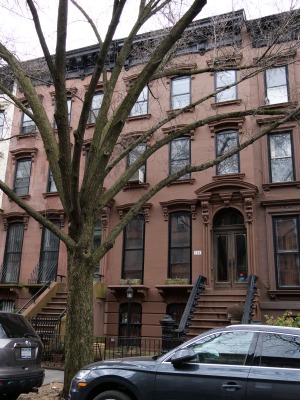 1871-1872: 122-130 Park Pl [s s 6th-7th Aves]
1871-1872: 122-130 Park Pl [s s 6th-7th Aves]
They have a late Italianate character which is belied by the date. Most notable are their arched doorways, similar to those at Nos. 118 and 120 their rusticated basements with sentimental arched windows; the shouldered cornices over their segmental-arched windows, which are carried on brackets; the deep parlor floor windowsills carried on console brackets and the arched profiles of the fascias between the brackets of their roof cornices. No. 122 best retains its original appearance, with its balustered cast iron handrailings and newel posts. No. 128 has had a fourth floor added retaining its original cornice at a higher level.
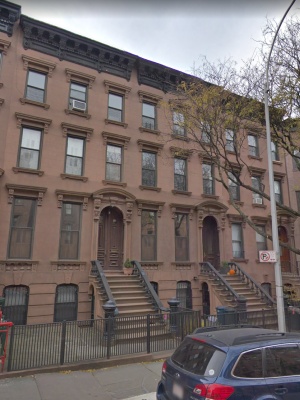 1873: 38-50 Sterling Pl [s s 5th-6th Aves]
1873: 38-50 Sterling Pl [s s 5th-6th Aves]
This row was found from a newspaper classified listing.
The house's brownstone stoop and facing, gabled and bracketed main entryway lintel, paneled, cut-glass main entryway doors with colonettes at the paneled jambs, molded window surrounds, and bracketed cornice are characteristics of the Italianate style.
The house's brownstone facing, rusticated basement, chamfered window openings with paneled keystones at the basement, round-arch main entryway topped by gabled hood on scrolled brackets; paneled, cut-glass main entryway doors with paneled jambs, bracketed sills, molded window lintels on scrolled bracket, bracketed cornice, and cast-iron areaway posts are characteristics of the Italianate style.
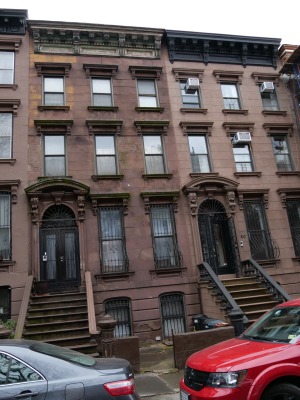 1874-1875: 44-62 St. Mark's Ave [s s 5th-6th Aves]
1874-1875: 44-62 St. Mark's Ave [s s 5th-6th Aves]
These ten similar Italianate style dwellings were designed and constructed by architect/developer John Magilligan, at a time when the western section of Park Slope was rapidly developing with houses and apartments for Brooklyn's growing middle class. The building's brownstone facing, round-arch main entryway topped by a gabled lintel on scrolled brackets, segmental-arched windows with molded window surrounds and bracketed lintels and sills, cast-iron newel posts, stoop balusters and railings, ornate fence and gate, and bracketed cornice are typical of the Italianate style.
The are differences between the left and right five houses. The cornice changes slightly, the corbels above the windows on the upper floors are more ornate on the right, and the stoop railings were wrought iron on the left, and cast iron on the right.
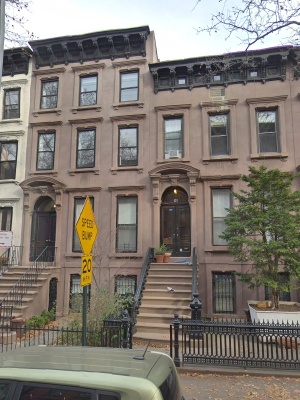 1876-1877: 89-97 Sterling Pl [n s 6th-7th Aves]
1876-1877: 89-97 Sterling Pl [n s 6th-7th Aves]
I found numerous newspaper classified listings for this row. The Landmark Designation report lists these with architect/builder Not Determined, but it has the developer as John Cunningham. And then writes he was the builder.
One of five (89-97 Sterling Place) Neo-Grec row houses built by John Cunningham at a time when western Park Slope was rapidly-developing with houses and apartments for Brooklyn's growing middle class. This row house features incised details at the window surrounds and a round-arch recessed entry with a curved pediment enframement.
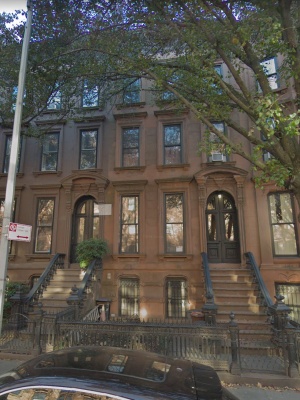 1879-1880: 118-120 Park Pl [s s 6th-7th Aves]
1879-1880: 118-120 Park Pl [s s 6th-7th Aves]
These flush-fronted brownstones with their window frames surrounded by cornices and handsome, arched double doors crowned by segmental arches, carried on brackets above keystones, reflect the new formality of the French influence in architecture. They retain their stoop and yard railings. Despite the difference of their appearance from Nos. 112-116, they were also constructed by John Magilligan in 1879-80 for Mary Magilligan.
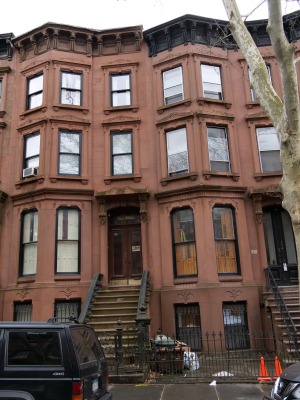 1880: 112-116 Park Pl [s s 6th-7th Aves]
1880: 112-116 Park Pl [s s 6th-7th Aves]
These three brownstones, so similar to Nos. 92-98. Even the roof cornices repeat the high, narrow, evenly spaced brackets of the adjacent houses at the west.
 1881: 56-64 Berkeley Pl [s s 5th-6th Aves]
1881: 56-64 Berkeley Pl [s s 5th-6th Aves]
These five similar Neo-Grec style dwellings were designed by architect John Magilligan and built in 1881, at a time when the western section of Park Slope was rapidly developing with houses and apartments for Brooklyn's growing middle class. The houses' brownstone stoop, angled bays, incised ornament, decorative main entryway doors, paneled jambs with colonettes, and bracketed cornice with frieze panels are characteristic of the style.
When Magilligan died in 1907 he was living in 56 Berkeley Pl, at the other end of the row from the house pictured. This was only two blocks from his church, in which he was active.
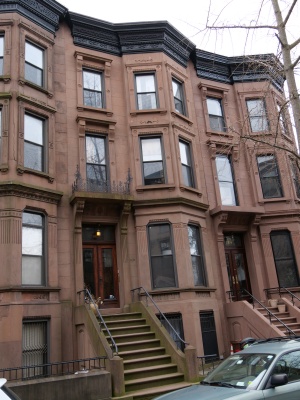 1882-1883: 184-202 Berkeley Pl [s s 7th-8th Aves]
1882-1883: 184-202 Berkeley Pl [s s 7th-8th Aves]
These ten neo-Grec brownstones were built during the years 1882-83 by owners Edward S. Sturges and John Magilligan, in association with architect Amzi Hill. These houses form a unified row although certain variations in detailing appear. They are three stories high above basements, have full-height, two-sided bays and all originally had high stoops. At three houses the stoops have been replaced by basement entrances. The original doorways have segmental arches, except for those at Nos. 184 and 186 which arc square-headed. All the doorways are flanked by grooved pilasters and brackets supporting simple cornice slab which are still crowned by delicate iron crestings with corner finials at many of the houses. Typical neo-Grec incised ornament adorns the window enframements and many of the windows are surmounted by "eared" pedimental lintels. The roof cornices, which follow the profiles of the bays, have panels between the brackets at Nos. 190-202 and are decorated with low relief ornament at Nos. 184-188.
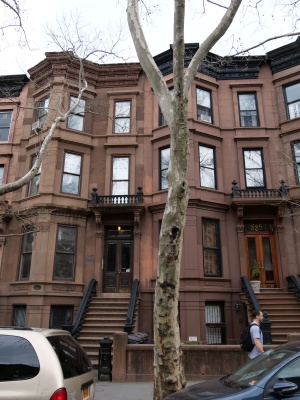 1884-1885: 865-887 Union St [n s 7th-8th Aves]
1884-1885: 865-887 Union St [n s 7th-8th Aves]
These twelve residences were built in 1884-85 by Park Slope builder-architect John Magilligan, who lived at that time just west of the District on St. Mark's Avenue. The brownstone row is quite uniform and straightforward in its neo-Grec design -- typical of Magilligan's work elsewhere in the District. All have full-height two-sided bays accented with horizontal bandcourses. The bays have full-height pilasters at their apexes, incised with conventional neo-Grec ornament. The deep, paneled roof cornices reflect the profiles of the bays and pilasters at the skyline. The cornice slabs over most of the main entrances are surmounted by low cast iron balustrades, in character with the heavy stoop handrailings. Basement entrances have been provided at Nos. 809, 873 and 685.
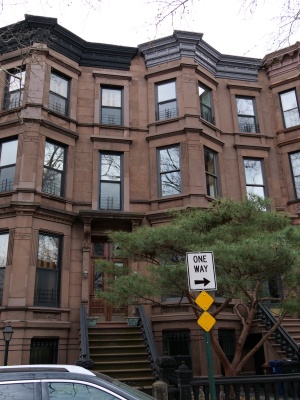 1886-1887: 749-763 Carroll St [n s 7th-8th Aves]
1886-1887: 749-763 Carroll St [n s 7th-8th Aves]
The first eight houses within the District on this side were begun in 1886 by the neighborhood architect-builder John Magilligan. These brownstones with full-height, two-sided bays are typical examples of the French neo-Grec style more fully described at Nos. 115-137 on the north side of St. John's Place. Of this three-story row above high basements, only two retain the cast iron handrailings, balusters, newels and yard railings of their stoops. It is likely that they all had small balustrades above the cornice slabs of the entrances, but only one remains, at No. 753. The roof cornices have moldings and panels.
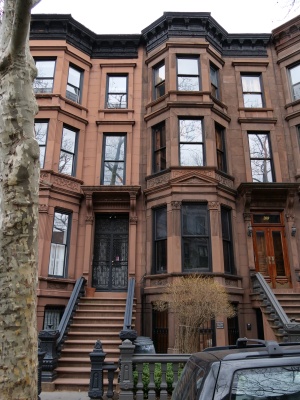 1887: 765-775 Carroll St [n s 7th-8th Aves]
1887: 765-775 Carroll St [n s 7th-8th Aves]
In 1887 John Magilligan began building these six brownstones, introducing to the blockfront full-height, three-sided masonry bays. In practically all respects, these buildings are similar to Nos. 927-941 President Street and have some neo-Grec detail. Many of the original cast iron balustered, yard railings and handrailings with sturdy newel posts remain at the stoops. At No. 765 and No. 769 the charming carved panels, beneath the central parlor ' floor windows, and the capitals of the pilasters of the bays are enlivened by cherub heads depicted in various moods. The roof cornices are similar to those of Magilligan's row to the west, with the addition of brackets.
Both houses in picture have lost their ironwork over the front door.
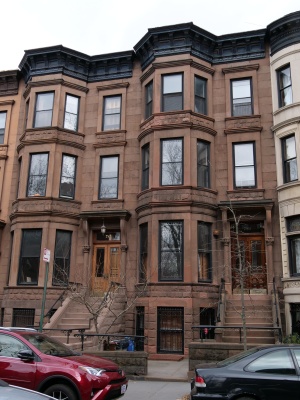 1888: 777-789 Carroll St [n s 7th-8th Aves]
1888: 777-789 Carroll St [n s 7th-8th Aves]
This row of seven brownstones was also built by owner-architect John Magilligan but was begun a year later, in 1888. Stylistically, the houses are similar to those he built across the street in 1889 (Nos. 786-794), with full-height bays with curved sides. These houses are approached by high, L-shaped stoops with low, rough-faced stone wing-walls. This rough-faced stonework reappears in bands beneath all the windows.
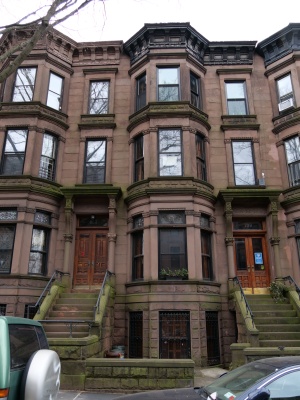 1889: 786-804 Carroll St [s s 7th-8th Aves]
1889: 786-804 Carroll St [s s 7th-8th Aves]
This row of nine houses occupies this entire blockfront. It was begun in 1889 by builder John Magilligan of Berkeley Place. They are three-story brownstones above high basements, with full-height, three-story masonry bays. Moldings provide horizontal accents and interesting shadows at each floor of the bays. With only one exception, all have retained their original rough-faced brownstone stoops and also their handsome, original double doors and doorways. The use of the rough-faced stone is repeated in broad bands beneath all the windows. Those houses are typical Park Slope brownstones of the late 1880s, with masonry transom bars and stained glass transoms at some of the parlor floor windows. In the work that Magilligan did on this block in the late 1880s, we see a stylistic progression typical of that followed by so many other builders in the area. Gradually the neo-Grec was superseded by the increasingly popular, more formal classical styles and by the Queen Anne style. No. 802-804 has a long brick facade with full-height bay and corbel chimneys on Fiske Place. No. 786 has an entrance on Polhemus Place.
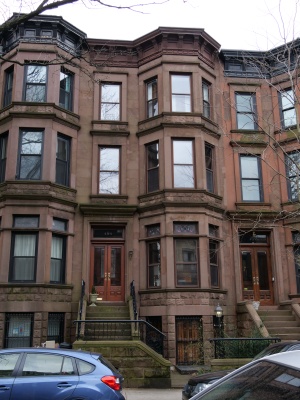 1891-1893: 480-498 1 St [s s 7th-8th Aves]
1891-1893: 480-498 1 St [s s 7th-8th Aves]
This long row of ten brownstones helps to unify this side of the street. Nos. 480-486 are known to have been erected by Brooklyn owner-architect John Magilligan in 1891-92. The rest of the row was probably also the work of Magilligan. They are very similar to the houses across the street, Nos. 503-509. Like so many houses in Park Slope, they have full-height, three-sided masonry bays, which extend from the basement floor to the roof cornice, and L-shaped stoops. Rough-faced stonework appears at the basements and stoops and in the band courses beneath the windows of the bays. Stained glass transoms ornament the parlor floor windows, and some of the stoops retain their original delicate wrought ironwork. Wooden roof cornices with neo-Grec detailing crown these severely rectangular buildings.
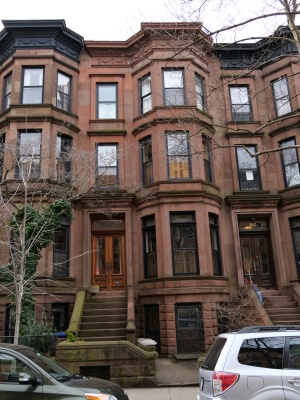 1894: 258-264 Garfield Pl [s s 7th-8th Aves]
1894: 258-264 Garfield Pl [s s 7th-8th Aves]
The next group of four houses was begun in 1894 by John J. Magilligan, owner-builder. Stylistically, these brownstone houses are similar to Nos. 230-238, except for the galvanized iron cornice with its Classical swag motif. A basement entrance has been provided at No. 260.
His first with galvanized iron cornices.
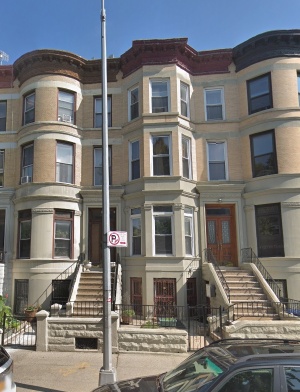 1895: 1263-1277 Bergen St [n s Brooklyn-Kingston Aves]
1895: 1263-1277 Bergen St [n s Brooklyn-Kingston Aves]
This row of houses was constructed c.1895 by John Magilligan, who also designed them. Constructed in an A-B-A-B-A-B-A-B arrangement, they are relatively austere but well-preserved examples of the Renaissance Revival style, retaining their alternating, full-height projecting angled and round bays, stone box stoops, and original bracketed cornices. The basement- and first-floor portions of their facades are of limestone; the upper portions of their facades are of tan colored brick, with continuous limestone lintel courses extending the full width of each house, and uniting the row.
A: Four bays, including a full-height, three-window-wide, angled projecting bay; metal window grilles at the basement floor; rough-faced stone box stoop with opening on front of cheek wall containing a metal grille; understoop opening with metal gate; paneled wood main entrance reveal; stone main entrance surround with carved foliate ornament and a projecting, molded cornice; continuous projecting molding above the basement windows; continuous projecting, molded stone sills at the first and second floors; projecting stone sill at the third floor; molding with foliate ornament at the first-floor window heads; projecting stone moldings above the first- and second-floor lintels on the projecting bay; continuous limestone lintel courses at the second and third floors; modillioned metal cornice with interlaced foliate ornament and an egg-and-dart molding.
B: Three bays, including a full-height, two-window-wide, bowed projection; one-over-one, double-hung wood sashes at the basement, second, and third floors; leaded-glass transoms at the first floor; metal window grilles at the basement floor; rough-faced stone box stoop with opening on front of cheek wall containing a metal grille; understoop opening with metal gate; pair of paneled wood-and-glass main entrance doors below a wood transom bar and window; stone main entrance surround with carved foliate ornament and a projecting, molded cornice; continuous, projecting molding above the basement windows; continuous projecting, molded stone sills at the first and second floors; projecting stone sill at the third floor; molding with foliate ornament at the first-floor window heads; projecting stone moldings above the first and second-floor lintels on the bowed projection; continuous limestone lintel courses at the second and third floors; modillioned metal cornice with foliate ornament and an egg-and-dart molding.